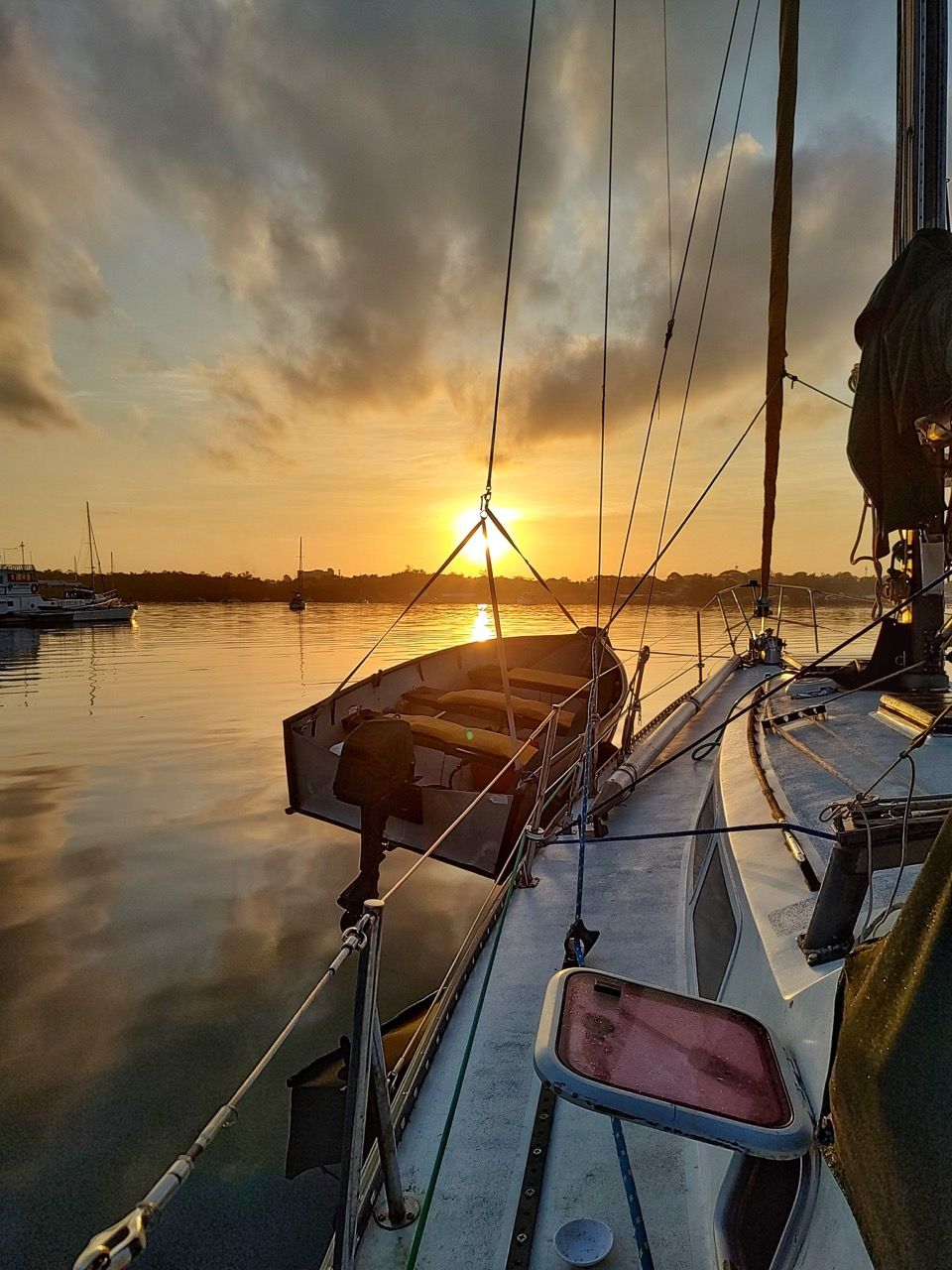Life On The Hook: 5 Tips For Comfortable and Safe Living On Anchor
From choosing the right ground tackle to mastering anchoring etiquette, Capt. Heather Francis shares practical advice for living on a boat.
Life on the hook offers a unique blend of adventure, solitude, and freedom. Although our recent experience spending ten days at a marina in Kota Kinabalu, Borneo, Malaysia, was a notable departure from our usual lifestyle, as it had been nine years since we were tied to a dock. While the conveniences of marina life, such as endless hot water showers and the sheltered security of our sailing yacht KATE, were initially appreciated, we soon longed for the freedom of being back on anchor. The ability to drop anchor in any suitable harbor offers a sense of independence that is hard to beat. Though life on anchor can be challenging, it can also be incredibly rewarding. Here are our top tips for making life on the hook safe and comfortable, drawn from years of experience and personal anecdotes.

Above: The sailing yacht KATE anchored in a bay in Palawan, Philippines. Photo by Heather Francis.
1. Choose And Maintain The Right Ground Tackle
The cornerstone of safe anchoring is having proper ground tackle that is reliable and well-maintained. During our travels, we’ve found that our 44lbs Bruce-style claw anchor and 90 meters of 8mm chain provide excellent holding power for our 41-foot, 10-ton monohull, KATE. This setup gives us the confidence to anchor comfortably in depths of up to 25 meters under fair conditions, using a 3 or 4-to-1 scope ratio. In more challenging conditions, a 5 to 7-to-1 scope ratio ensures greater holding strength.
There are lots of anchor styles to choose from, and opinions about which style is best abound, so it pays to do some research. A good place to start are manufacturers websites where proper size guides can be found. It is also important to consider what type of rode you carry, all chain or chain and rope.
Regular maintenance is crucial. We've learned that mud can be surprisingly acidic, while rocks and sand can abrade the chain over time. Periodically, we raise our anchor to inspect and clean the chain, preventing damage and ensuring longevity. It’s a small effort that pays off in peace of mind.
2. Practice Proper Anchoring Etiquette
We’ve often found ourselves anchored in a spacious bay, only to have other boats drop anchor uncomfortably close. This not only invades privacy but also raises safety concerns. When anchoring, consider the swing room needed for both your vessel and others. For example, if each boat has 50 meters of chain out, they should ideally be over 100 meters apart to avoid collisions as they swing.
Different types of boats, like monohulls and catamarans, behave differently on anchor due to their hull shapes. Each one ‘dances’ on anchor a little differently due to how the hulls react to the wind. Additionally, factors such as tides, currents, and wind variations can affect how boats swing. Always give ample space to other vessels and be mindful of noise and wake, especially when running engines or generators. This is all to say, the safest and most polite thing to do is to give other vessels in the anchorage plenty of swing room. Respecting these unwritten rules makes for a more pleasant experience for everyone.

Above: View from aboard SY KATE in El Nido, Philippines. Photo by Heather Francis.
Anchorage etiquette also includes being mindful of noise and wake. If you have to run a generator or your engine to charge batteries, do it during reasonable daylight hours and preferably not for more than a few hours at a time. If you like to rock out in the cockpit after dinner with your mates, shut the karaoke competition down at a reasonable hour. As anyone who has had to endure the late-night ramblings of the boat next door can confirm, sound carries very well over water, especially when it is calm.
A harbor busy with dinghies going to and from shore can quickly turn a calm anchorage into chaos. Consider every anchorage a ‘No Wake” zone and leave the high-speed dinghy maneuvers until you are away from other vessels.

Above: Captain Heather Francis enjoying some quiet time in a remote cove anchorage in Coron, Philippines. Photo via Heather Francis.
3. Select The Right Dinghy for Your Needs
Your dinghy is your lifeline when living on anchor. It’s essential to choose one that meets your needs, whether it’s for quick trips to shore or longer excursions. Remember that when you are on anchor your dinghy is really your main mode of transportation. We’ve found that a lightweight, easily stowable dinghy is invaluable, especially when landing on diverse shorelines, from sandy beaches to rocky outcrops. Of course, there is no one-size-fits-all solution, but it is important to consider your needs carefully. For a deep dive into dinghies, read our detailed Guide To Choosing The Right Dinghy.

Above: Selecting The Right Dinghy is vital for living on anchor. Photo by Heather Francis.
4. Always Have a Plan B
Weather and conditions can change unexpectedly, turning a peaceful anchorage into a challenging environment. I am constantly surprised how a slight change in wind or swell direction can turn a dream anchorage into a nightmare. Which is why we always have a Plan B. Sometimes, this means setting a stern anchor to counteract strong tidal currents, or moving to a more sheltered part of the bay. On certain memorable nights, sudden squalls have forced us to quickly weigh anchor and relocate to the another side of the bay for more protection. Other times, when the weather kicks up in the middle of the night and moving is more perilous than the conditions on board, we will sit anchor watch.
Either way, being prepared for such scenarios means keeping the boat tidy and ready to move. We make it a habit to secure loose items, keep the cabin uncluttered and ensure that essential gear is within easy reach. It is easy to get complacent after a few days on anchor in pristine conditions. So I remind myself to make sure things like headlamps and life vests are in their usual, easy to grab spots, and that items on deck like sunshades are secured or taken down. I have never regretted taking those few extra minutes at the end of the day. In fact, this preparedness has saved us countless times from potentially hazardous situations.
5. Be Well-Stocked And Prepared
For us, the allure of living on anchor is the opportunity to explore places that are not on the tourist map. However, to spend time away from the hustle and bustle you must be well stocked and prepared. Food, fuel, and water are always high priority. We always stock enough dry goods and staples to last about a month, with a 50% buffer for unexpected delays. On more than one occasion, unexpected mechanical issues or bad weather have extended our stays beyond the planned duration.
Water management is another critical aspect. Although we have a watermaker on board, we’re always mindful of water quality, especially in areas where muddy rivers discharge into the sea nearby our anchorage. To ensure we have enough potable water, I keep twenty-four liters of separate clean water on hand so that we always have drinking water, even if we do run the tanks dry. Additionally, I collect water when it rains to top up our shower bag or do laundry. Knowing how and where you can find potable water is important.
It is also necessary to stay on top of things like visitors VISA’s, if sailing in a foreign country and away from urban centers, and to make sure you have enough tools and spares on board to get you out of trouble. Being self-sufficient also extends to having up-to-date medical supplies and the necessary tools and spare parts to handle minor repairs.
Take Aways
Living on anchor offers unparalleled freedom and the joy of exploring hidden gems away from crowded marinas, but it is all about being safe and self-sufficient. By sharing our personal experiences and tips, we hope these insights can help you navigate the challenges and reap the rewards of living on anchor. It takes a little planning to give the marina the slip and get into the swing of things, but once you try it, you’ll be "hooked"!












